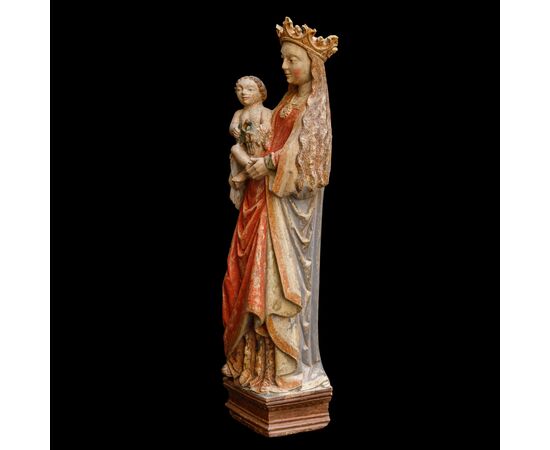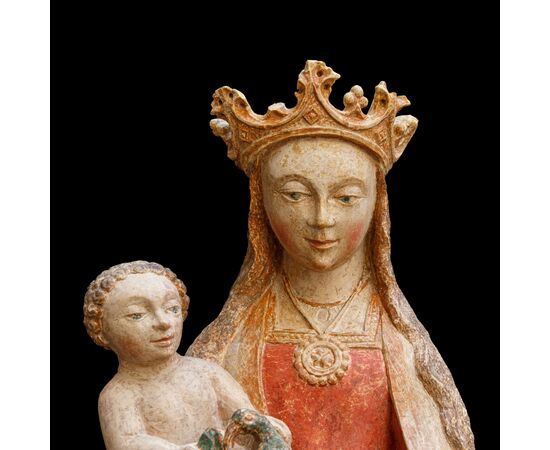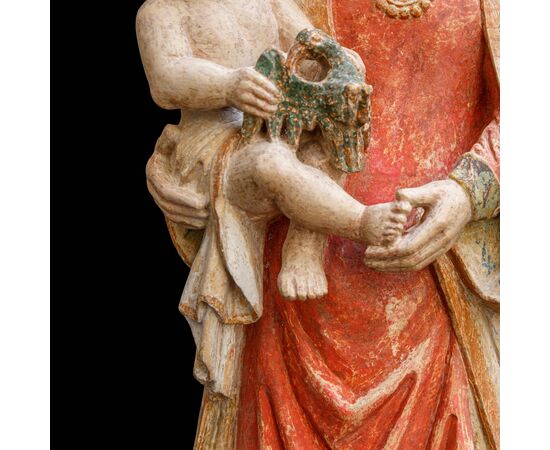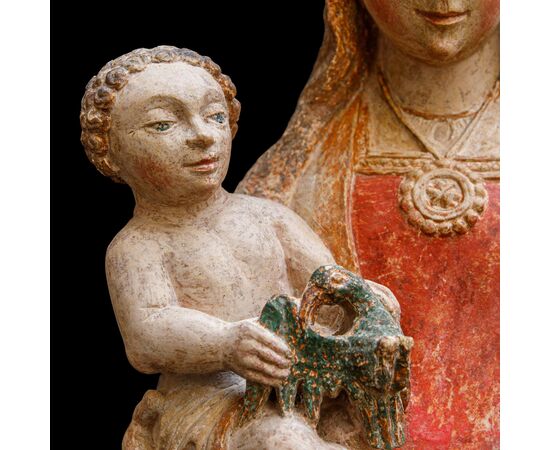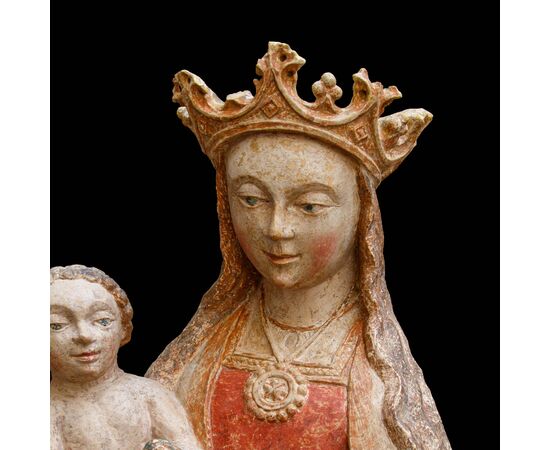Alsace-Lorraine, 15th century, Madonna with Child
Alsace-Lorraine, 15th century Madonna with Child Polychrome sandstone, height 62 cm This polychrome stone sculpture, attributable to the Alsatian school of the 15th century, captures a moment of intimate sweetness and majesty. The Virgin Mary is depicted standing, with a serene and regal expression, further emphasized by the crown adorning her head. Her features are delicate, and her gaze seems directed towards the viewer with a profound stillness. In her arms, she tenderly holds the Child Jesus. The little one is portrayed in a lively pose, with marked dynamism, almost wanting to interact with the outside world, blessing or simply offering his presence to humanity. The divine Child holds a pelican in his little hands; in the Christian world, also following a symbolic work – the Physiologus (4th century AD) – the image of the pelican will gradually establish itself as a symbol of the Eucharistic Christ who feeds his flesh and blood for the life of his children. The pelican thus lends itself to a dual symbolism: it is understood both as an image of Christ who lets himself be crucified and gives his blood to redeem humanity, and as an image of God the Father who sacrifices his Son, resurrecting him from the dead after three days. The polychromy adds an element of vivacity and realism to the sculpture. Clearly visible traces of color can be distinguished on the Virgin's robes, denoted by the presence of golden decorations or stylized floral motifs, typical of the aesthetics of the International Gothic period. The drapery of the robes is rendered with elegant and sinuous folds, which give movement to the majestic figure. The sculpture emanates a strong spirituality, typical of the religious works of the period. The relationship between the Mother and the Child is at the center of the representation, constituting a fundamental theme in Christian iconography. The mastery of the 15th-century French sculptor is manifested in the ability to infuse humanity and divinity into this touching image. The sculpture exhibits multiple key characteristics of the plastic production of 15th-century Alsace-Lorraine: Alsatian sculptures are distinguished by the great expressiveness of the figures, the extreme care in the drapery, which is particularly defined, the bright and varied polychromy, which often includes the presence of golden details, and the coexistence of artistic influences connected to the German and French spheres. The rich decoration of the dress, which infuses an aura of preciousness to the figure of the Virgin, refers to the sphere of late International Gothic. France boasts a rich tradition of sandstone sculptures: this material, relatively malleable and easily available, was used in particular to create works of great visual and symbolic impact, especially of a religious nature. French sandstones, known for their variety of colors and textures, were used, especially at the turn of the Middle Ages and the Renaissance, in figurative, architectural, and decorative sculptures, offering a wide range of expressive possibilities. The geographical position of Alsace-Lorraine, a borderland between France and Germany, means that the sculpture presents suggestions connected to both cultural spheres. The monumentality of the forms seems to look to the most excellent examples of French sculpture at the turn of the Late Gothic and Renaissance periods: we need only think of the imposing plastic works of Claus Sluter, originally from Haarlem in Flanders but active throughout his life between Dijon and Champmol, such as the so-called Well of the Prophets and the Annunciation of the portal of the Chartreuse de Champmol. The relationship between the Virgin and the Child also shows various analogies with the sculptures of Claus Sluter's nephew, Claus Van de Werve, a master highly appreciated in the French context in the first half of the fifteenth century. The marked colorism and the defined features of the Virgin's face, as well as the touch of preciousness of Gothic derivation in the crown and the golden damask mantle, are instead of German tradition: a recovery of the models of the Master of the Naumburg Cathedral and Veit Stoss is noted, known for his wooden sculptures in Leipzig and Dresden.




